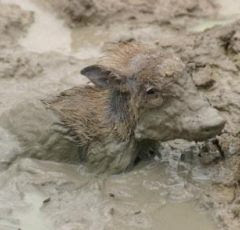 The optimistic lesson of geology is found in its 'the scale of time'. Breifly, 1st there's the Precambrian era which is about 7/8 of the earth's entire history and is primarily defined as the period before which almost no fossils can be found because during those long 4 thousand million years there were no skeletons, no bones, no teeth. Then the Paleozoic, the next 250 millon years before the present, defined as the era between the arrival of those first megascopic fossils and the great Permian extinction when fully 1/2 of all fish, 3/4 of all amphibians and 96% of all marine fauna suddenly diappeared. Then the Mesozoic, the next 100 million years ending with the Cretaceous Extinction, often called the 'age of reptiles', which now seems to have ended with the impact of an Apollo object crashing into and through the Yucatan and leaving its Iridium signature as a thin line found everywhere around the globe. Finally, the 154 million years of the Cenozoic which starts when the dinosaurs say adios and continues until now.
The optimistic lesson of geology is found in its 'the scale of time'. Breifly, 1st there's the Precambrian era which is about 7/8 of the earth's entire history and is primarily defined as the period before which almost no fossils can be found because during those long 4 thousand million years there were no skeletons, no bones, no teeth. Then the Paleozoic, the next 250 millon years before the present, defined as the era between the arrival of those first megascopic fossils and the great Permian extinction when fully 1/2 of all fish, 3/4 of all amphibians and 96% of all marine fauna suddenly diappeared. Then the Mesozoic, the next 100 million years ending with the Cretaceous Extinction, often called the 'age of reptiles', which now seems to have ended with the impact of an Apollo object crashing into and through the Yucatan and leaving its Iridium signature as a thin line found everywhere around the globe. Finally, the 154 million years of the Cenozoic which starts when the dinosaurs say adios and continues until now. The problem is that humans think in five generations-two ahead, two behind- with heavy attention on the one in the middle. On a geologic timescale a human lifetime is reduced to a brevity that is to inhibiting to think about, it's like my mind almost blocks the information.
Geologists will sometimes use the calendar year as a unit to represent the scale of time and a symbolic way around our trickster minds. In such a timeframe the Precambrain runs from New Year's Day until after Halloween. Dinosaurs appear in the middle of December and are gone by the day after Christmas. The last ice sheet melts on December 31st at one minute before midnight. The Roman Empire lasts 5 seconds. With your arms spread wide to represent all the history of our earth, look at one hand, the Cambrian begins in the wrist and the Permian Extinction is at the outer end of the palm. All the Cenozoic is in the fingerprint, and a single stroke of a medium grained nail file could eradicate human history.
Most all of this is paraphrased from one section of 'Basin and Range', the first of 5 books in a series by John McPhee called 'Annals of the Former World'. Each of them stands alone quite easily and they were published seperately over a period of about 20 years. The set is in our Gibson's library and i hope in every library everywhere.
How liberating it is during those fleeting moments when i catch a glimpse of deep time. How uplifting to realize all the sins and selfish delusions of our 'civilization' will one day amount to no more than a pencil thin line of stainless steel here and there, maybe a blob of bronze or a bit of fossil. The birds will sing the fish will swim long after our remains have been subducted into an oceanic trench. Round and round we go, might as well dance.


